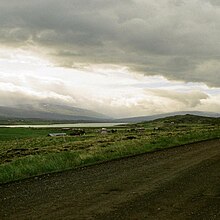Fljótsdalshérað

|
|
| Basic data | |
|---|---|
| State : |
|
| Region: | Austurland |
| Constituency : | Norðausturkjördæmi |
| Sýsla : | Norður-Múlasýsla |
| Population: | 3600 (January 1, 2019) |
| Surface: | 8884 km² |
| Population density: | 0.41 inhabitants / km² |
| Post Code: | 700, 701 (Egilsstaðir) |
| politics | |
| Community number | 7620 |
| Mayor: | Eiríkur B. Björgvinsson |
| Contact | |
| Website: | www.egilsstadir.is |
| map | |

Coordinates: 65 ° 16 ′ N , 14 ° 24 ′ W |
|
The municipality of Fljótsdalshérað (Isl. Sveitarfélagið Fljótsdalshérað ) is an Icelandic municipality in the Austurland region .
Fljótsdalshérað is the largest municipality in Iceland with 8,884 km². Of the 3600 inhabitants, 2501 live in the main town of Egilsstaðir (as of January 1, 2019). The only other urban settlement is Fellabær with 398 inhabitants. Both places have seen strong population growth in recent years. Eiðar and Hallormsstaður are among the smaller, meanwhile no longer classified as urban places with declining population .
geography
The large municipal area extends from the bay Héraðsflói in the northeast to Vatnajökull in the southwest.
At the main town of Egilsstaðir lies the elongated lake or the river Lagarfljót , also known as Lögurinn.
Iceland's largest forest, Hallormsstaðaskógur, is about 25 km south of Egilsstaðir . It emerged from a tree nursery for reforestation attempts from the beginning of the 20th century. Reforestation programs can be found in the whole area, cf. for example Eyjolfsstaðurskógar. The forests and copse are often very well developed with hiking trails and their course is shown on maps that are available for free. The city itself is also interspersed with many trees and other larger plants.
Adjacent municipalities are Skútustaðir in the west , Norðurþing and Vopnafjörður in the north, Borgarfjörður , Seyðisfjörður in the northeast, Fjarðabyggð and Breiðdalur in the east and Djúpivogur and Fljótsdalur in the south .
history
The large community was formed on November 1, 2004 through the merger of three communities, two of which were large communities that were formed in the 1990s:
- Municipality of Norður-Hérað, formed on December 27, 1997 through the merger of the three rural municipalities Hlíð ( Hlíðarhreppur ), Jökuldalur ( Jökuldalshreppur ) and Tunga ( Tunguhreppur )
- Austur-Hérað municipality, formed on June 7, 1998 by the merger of the town of Egilsstaðir ( Egilsstaðabær ) with the four rural municipalities Hjaltastaður ( Hjaltastaðahreppur ), Skriðdalur ( Skriðdalshreppur ), Vellir ( Vallahreppur ) and Eiðar ( Eiðahreppur )
- Rural community Fell ( Fellahreppur )
On October 26, 2019, a vote on the merger with 3 other municipalities took place. The new church will be called Múlaþing .
Transport and infrastructure
Iceland's most important road, Hringvegur, runs through Egilsstaðir. The Egilsstaðir Airport is at the same (next to Akureyri ) an alternative landing site for Iceland's international Keflavik airport .
climate
The annual mean is 4.0 ° C. The warmest month is July, the coldest January. Most of the precipitation of the year falls in January.
Daughters and sons of the church
- Bjarni Benediktsson frá Hofteigi (1922–1968), writer

